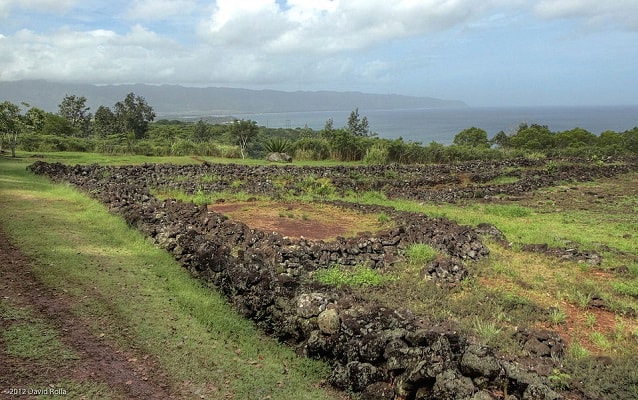Last updated: August 16, 2019
Place
Pu'u o Mahuka Heiau, HI

Photo by Davidr.808, CC BY-SA 3.0, https://commons.wikimedia.org/w/index.php?curid=21506039
Pu'u o Mahuka Heiau is located in Pu'u o Mahuka Heiau State Historic Site on the Island of Oahu and is the largest heiau (place of worship) on the island, encompassing over two acres. Overlooking Waimea Bay, the heiau is situated 300 feet above the sea on a high bluff. Pu'u o Mahuka Heiau served a critical role in the religious, social, and political system of Waimea Valley, a major cultural center on the north shore of Oahu.
Waimea Valley has rich agricultural lands, fresh water, abundant offshore marine resources, and good canoe landing sites, making it an ideal location to sustain a large population. Traditionally ali'i (chiefs) and kahuna (priests) searched for areas such as Waimea to establish centers of power. In the 1100s control of Waimea Valley was given to a line of kahuna nui (high priests) to serve as their spiritual headquarters. For the next 700 years, the kahuna nui passed down control of the valley as a sacred "Valley of the Priests."
Early Hawaiian shrines were simple and constructed by families and small communities. With population growth and changes in religion, social organizations became more complex and large heiau were constructed for public ceremonies. Ancient Hawaiians had many types of heiau, each with their own distinct function and use by particular segments of society. Heiau ranged in size from a single upright stone to massive and complex structures.
Larger heiau were built by ali'i, but the largest and most complex, the luakini heiau (sacrificial temple), could only be constructed and dedicated by an ali'i 'ai moku (paramount chief of an island or independent chiefdom). Luakini heiau were reserved for rituals involving human or animal sacrifice and highlighted the ali'i 'ai moku'sspiritual, economic, political, and social control over his lands and his authority over the life and death of his people.
Pu'u o Mahuka Heiau was most likely constructed as a luakini heiau in the 1600s. The heiauis in a low-walled court platform style with a series of three enclosures and stacked rock walls originally ranging from three to six feet in height. Basalt and coral stones paved the interior surface. Within the largest enclosure were several wood and thatch structures. More than likely, the upper, eastern enclosure was constructed first, and was the ceremonial focus of the heiau. The other two enclosures were probably added in the 1700s. Located on a ridge with a direct view of the Island of Kauai, Pu'u o Mahuka Heiau had ties with the various heiau at Wailua on Kauai. Reportedly, signal fires at these heiau provided a means of visual communication between the two islands.
In 1792, Captain George Vancouver of the British Royal Navy anchored his ship Daedalusoff the Waimea River, and sent some of his men ashore to collect water. A scuffle ensued with the Hawaiians that resulted in the killing of three of Vancouver's men. In 1795, when Kamehameha I conquered Oahu, Kahuna Nui Hewahewa, Kamehameha's personal kahuna, conducted religious ceremonies at the heiau. Pu'u o Mahuka Heiau was used up until 1819, when, after Kamehameha's death, his son and heir Liholiho abolished much of the Hawaiian religious system and ordered the destruction of all heiau on the islands.
Pu'u o Mahuka Heiau, a National Historic Landmark, is located on the Island of Oahu in Pu'u o Mahuka Heiau State Historic Site, Pupukea, HI.Pu'u o Mahuka Heiau State Historic Site is on the North Shore of Oahu, above Waimea Bay. The site is just south of the town of of the town of Pupukea, HI off of Kamehameha Highway (Highway 83) and Pupukea Road (Highway 835) on Pu'u o Mahuka Road. The site is open daily during daylight hours and has interpretive signs and trails. There is no admission fee. For more information and a park brochure, visit the Pu'u o Mahuka Heiau State Historic Site.
